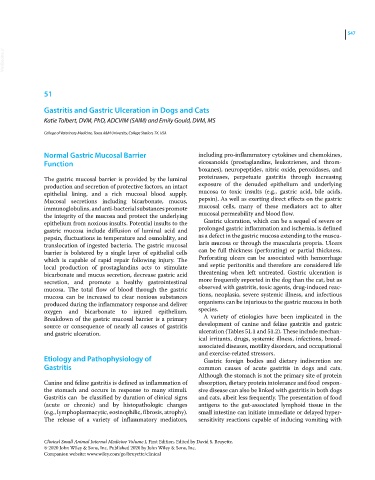Page 579 - Clinical Small Animal Internal Medicine
P. 579
547
VetBooks.ir
51
Gastritis and Gastric Ulceration in Dogs and Cats
Katie Tolbert, DVM, PhD, ADCVIM (SAIM) and Emily Gould, DVM, MS
College of Veterinary Medicine, Texas A&M University, College Station, TX, USA
Normal Gastric Mucosal Barrier including pro-inflammatory cytokines and chemokines,
Function eicosanoids (prostaglandins, leukotrienes, and throm-
boxanes), neuropeptides, nitric oxide, peroxidases, and
The gastric mucosal barrier is provided by the luminal proteinases, perpetuate gastritis through increasing
production and secretion of protective factors, an intact exposure of the denuded epithelium and underlying
epithelial lining, and a rich mucosal blood supply. mucosa to toxic insults (e.g., gastric acid, bile acids,
Mucosal secretions including bicarbonate, mucus, pepsin). As well as exerting direct effects on the gastric
immunoglobulins, and anti-bacterial substances promote mucosal cells, many of these mediators act to alter
the integrity of the mucosa and protect the underlying mucosal permeability and blood flow.
epithelium from noxious insults. Potential insults to the Gastric ulceration, which can be a sequel of severe or
gastric mucosa include diffusion of luminal acid and prolonged gastric inflammation and ischemia, is defined
pepsin, fluctuations in temperature and osmolality, and as a defect in the gastric mucosa extending to the muscu-
translocation of ingested bacteria. The gastric mucosal laris mucosa or through the muscularis propria. Ulcers
barrier is bolstered by a single layer of epithelial cells can be full thickness (perforating) or partial thickness.
which is capable of rapid repair following injury. The Perforating ulcers can be associated with hemorrhage
local production of prostaglandins acts to stimulate and septic peritonitis and therefore are considered life
bicarbonate and mucus secretion, decrease gastric acid threatening when left untreated. Gastric ulceration is
secretion, and promote a healthy gastrointestinal more frequently reported in the dog than the cat, but as
mucosa. The total flow of blood through the gastric observed with gastritis, toxic agents, drug‐induced reac-
mucosa can be increased to clear noxious substances tions, neoplasia, severe systemic illness, and infectious
produced during the inflammatory response and deliver organisms can be injurious to the gastric mucosa in both
oxygen and bicarbonate to injured epithelium. species.
Breakdown of the gastric mucosal barrier is a primary A variety of etiologies have been implicated in the
source or consequence of nearly all causes of gastritis development of canine and feline gastritis and gastric
and gastric ulceration. ulceration (Tables 51.1 and 51.2). These include mechan-
ical irritants, drugs, systemic illness, infections, breed‐
associated diseases, motility disorders, and occupational
and exercise‐related stressors.
Etiology and Pathophysiology of Gastric foreign bodies and dietary indiscretion are
Gastritis common causes of acute gastritis in dogs and cats.
Although the stomach is not the primary site of protein
Canine and feline gastritis is defined as inflammation of absorption, dietary protein intolerance and food respon-
the stomach and occurs in response to many stimuli. sive disease can also be linked with gastritis in both dogs
Gastritis can be classified by duration of clinical signs and cats, albeit less frequently. The presentation of food
(acute or chronic) and by histopathologic changes antigens to the gut‐associated lymphoid tissue in the
(e.g., lymphoplasmacytic, eosinophilic, fibrosis, atrophy). small intestine can initiate immediate or delayed hyper-
The release of a variety of inflammatory mediators, sensitivity reactions capable of inducing vomiting with
Clinical Small Animal Internal Medicine Volume I, First Edition. Edited by David S. Bruyette.
© 2020 John Wiley & Sons, Inc. Published 2020 by John Wiley & Sons, Inc.
Companion website: www.wiley.com/go/bruyette/clinical

